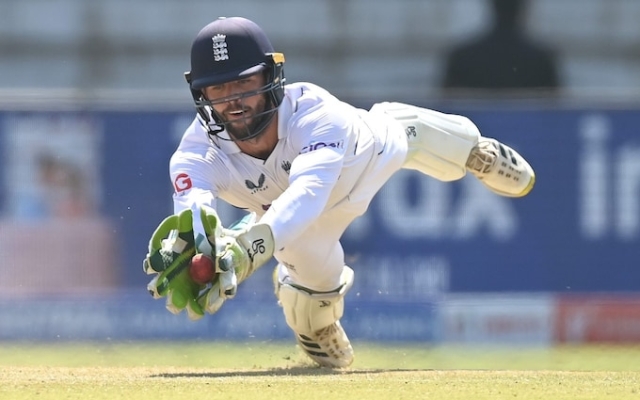 Ben Foakes is the best wicket-keeper in world cricket, but that alone cannot guarantee him a place in the Test team. Photo: Getty Images/Gareth Copley Previous England selection committees have allowed rumors that a player was about to be dropped, or dropped him out of the blue. The regime of Robert Key, Brendon McCullum and Ben Stokes has taken a different, silent approach: if a player does not receive public support during or at the end of a Test series, it is time for him to worry about his place.
Ben Foakes is the best wicket-keeper in world cricket, but that alone cannot guarantee him a place in the Test team. Photo: Getty Images/Gareth Copley Previous England selection committees have allowed rumors that a player was about to be dropped, or dropped him out of the blue. The regime of Robert Key, Brendon McCullum and Ben Stokes has taken a different, silent approach: if a player does not receive public support during or at the end of a Test series, it is time for him to worry about his place.
Alex Lees was the first to receive a silent vote of no confidence from England's Test selectors. Now it is the turn of Jonny Bairstow and Ben Fox after their moderate Test series with the bat in India. As attention turns to the T20 World Cup, it looks like someone new will be selected as the next batsman for the England team that starts against the West Indies on July 10 at Lord's.
< p>Here are the six players considered the leading candidates (vote for your choice below):
Johnny Bairstow 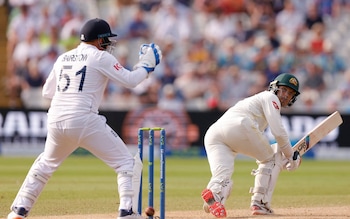 Johnny Bairstow's continued position on the stumps was influenced by his severe leg injury. Photo: Action Images via Reuters/Andrew Moggridge
Johnny Bairstow's continued position on the stumps was influenced by his severe leg injury. Photo: Action Images via Reuters/Andrew Moggridge
There was a time when Bairstow was an ideal number 7 — given the odd human error — until Ed Smith became England's chairman of selectors and promoted him to number 5; untenable position for a wicket. It is now too late to turn back the clock: Bairstow is a professional batsman and occasional wicketkeeper because, after major leg surgery, he is not flexible enough for the acrobatics required. Yes, brilliant diving for one-handed catches while standing behind, but no longer for holding spinners for long periods of time. Another point that came out of last winter: having scored his 100th Test boundary, does he have the desire to pull himself together and score big when needed? In India, when he started but didn't reach 40, it was clear that his mindset was: don't hang around.
Running ability 8/10< br /> Keeping the wicket 6/10
Tail Strike 9/10
Superpower All guns blazing as if in pursuit.
Jonny Bairstow interview with Ben Fox  Fawkes played 12 Tests under Ben Stokes. rank of captain, average score 27.68. Photo: Getty Images/PUNIT PARANJPE
Fawkes played 12 Tests under Ben Stokes. rank of captain, average score 27.68. Photo: Getty Images/PUNIT PARANJPE
After one early failure in India, he had an almost flawless winter behind the stumps. If there was a better wicket-keeper in the world, especially when it came to spinners, no one seemed to know his or her name. Some catches, after the batsman's edge caused the ball to deflect at a relatively large angle, were under-appreciated. But just 205 runs in 10 innings was not enough. And his Test career strike rate of 47 — in other words, less than three runs per over — will be sufficient in England against lesser teams, but not in Australia in 20 months if the top order falters and the tail is exposed. And it's probably fair to add that if he could have used more swing weight in his swing, he would have done so by age 31. It's like Joe Root and T20. Focal hitting and power hitting don't mix.
Running ability7/10
Wicket keeping10/10
Batting tail6/10
SuperpowerResistance to stump spinners.
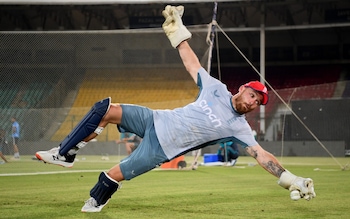 Phil Salt has many commitments to the white ball. Photo: Getty Images/Alex Davidson
Phil Salt has many commitments to the white ball. Photo: Getty Images/Alex Davidson
As with Bairstow, his qualities are physical strength, combativeness, athleticism and efficiency rather than agility, be it batting or keeping wicket. More rugged than sleek, but that doesn't matter at a crucial moment in a Test match. What matters is that Salt, at 27, is more of a white-ball cricketer than a red-ball cricketer, although not to the same extent as Jos Buttler at the same age. Salt made an early start to the Championship as a batsman in the Sussex top order and scored six first-class runs, while Buttler scored seven throughout his career. Sticking with the red ball and all its stats, Salt's relative inexperience may take its toll. All in all, he would be a prime candidate if England were looking for a wicketkeeper who could make it into the top order of their Test team; this is less true of the keeper bat at seven, although he will undoubtedly be persistent if given the task of batting with the tail. Moreover, Salt has so many white-ball commitments that he could not, like Buttler, devote all his energy to becoming England's first choice wicketkeeper.
The ability to make runs
The ability to make runs 8/10
Wicket care6/10
Tail beat 8/10
Super strength Fearless physical strength in everything he does.
Phil Salt Interview with Ollie Robinson 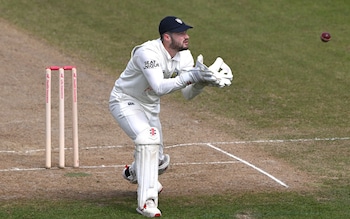 Ollie Robinson fits the bill on three counts. Photo: Getty Images/Stu Forster
Ollie Robinson fits the bill on three counts. Photo: Getty Images/Stu Forster
The most qualified of the new candidates, but that doesn't mean he'll get the job. He may seem to have come from nowhere, but he actually comes from Kent, like many of England's best goalkeepers such as Les Ames, Godfrey Evans and Alan Knott (and like them, he didn't go to a fee-paying school) . as most batsmen do today). Having failed to secure a white-ball position at Kent, he moved to Durham and blossomed, particularly as a red-ball batsman at number five. In Durham's only win this season against a revitalized Kidderminster, his 50 counter-attacks on the first day — particularly strong in the snatch and leg kick — put them in first place; and in his last innings he scored an unbeaten career-best 171 from 206 balls, taking them close to their target of 475. But the question about his wicket is how good is he to his left? — arose during that game against Lancashire. When their left-hander, Keaton Jennings, took the lead early in the game, Robinson jerked to his right while the ball flew right between the keeper and the first miss, which was the keeper's catch. The media would be delighted with such a miss in the test. In a championship match this might have been overlooked had it not been for the fact that Jennings hit a decisive century and in the middle of the match stood… Ben Stokes.
Ability to make runs
Ability to score runs > 8/10
Wicket keeping 7/10
Tail batting8/10
Super strength Counterattack like Bairstow did and Fox didn't.
Ollie Robinson, interview with Jamie Smith 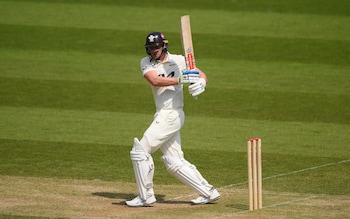 It would be a waste of Jamie Smith's remarkable talent with the bat to saddle him with gloves, just as Alec Stewart was. Photo: Getty Images/Alex Davidson
It would be a waste of Jamie Smith's remarkable talent with the bat to saddle him with gloves, just as Alec Stewart was. Photo: Getty Images/Alex Davidson
In 1991–92, England introduced outstanding opening batsman Alec Stewart. They could start the post-Gooch era with a high-quality complementary opening partnership between defensive end Mike Atherton and attacking Stewart. Instead, the selectors forced Stewart to refuse the order and keep wicket, and a decade of mediocrity followed. Don't make the same mistake this time. Smith can keep wicket like Foakes on a bad day, but he is an outstanding batsman in any format and should be allowed to concentrate on that (he could be a reserve wicketkeeper on a quiet winter tour, like Ollie Pope, but that's about it). His kick? Let's say Joe Root starts now, does all the strength training and does all the T20 power shots from birth: that's what Smith is. One dazzling talent in red-ball cricket at number 4, but also a brilliant, knee-bending, muscle-flexing power hitter — and already a top scorer for the Lions. What about his 45 off 25 in Surrey's chase against Somerset in April? Please don't spoil it this time either.
Ability to score runs10/10
Keeping wicket4/10< br/>Tail Slam 7/10
Superpower In one simple word — slam.
Jamie Smith interviews James Ryu  James Ryu bats like a traditional number 6. Photo: Getty Images/Harry Trump
James Ryu bats like a traditional number 6. Photo: Getty Images/Harry Trump
It would be an ideal form of higher education — after King's College Taunton, Buttler's alma mater — if Rew, aged 20 and four months, could now keep an eye on Jack Leach and Shoaib Bashir at the same time; but the choice of two professional spinners seems to be outlawed in English cricket, so he has to settle for one or the other, and sometimes neither. Meanwhile, in the Somerset seamers, he makes a brilliant one-handed catch at full stretch to his right — and he is naturally left-footed. As a batsman he is like an old-fashioned number 6, playing quietly and calmly before showing off his batting: exactly what you would want if England were to collapse in the next Ashes series, but not what the management would want in seven matches against smaller countries. before that. When Reju tried to start more aggressively earlier this season, it didn't work, but now he can once again score first-class runs (seven so far) at his own pace.
Ability to score runs 8/10
Wicket Keeping8/10
Tail Batting 6/10
Super Strength< /strong> His calmness at the start of the innings, highlighted by his quick and decisive footwork in delivering the ball.
Interview with James Rew Now you can tell…


























































Свежие комментарии